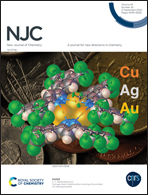Synthesis and X-ray characterization of antipyrine-tethered organosilanes and their magnetic nanoparticles: potent anti-oxidants and receptors for Sn(ii) ions†
Abstract
The present work explores the facile synthesis of antipyrine-based triazole-linked organosilanes (3a–3f) by employing the click chemistry methodology; the structure of one of the organosilanes 3(e) was authenticated using the X-ray crystallographic technique. The synthesized antipyrine-tethered organosilanes were surveyed for the detection of metal ions using absorption spectroscopy, and it was observed to show sensitivity for Sn2+ ions. The sensing probe 3(e) showed significant selectivity for Sn2+ ions with a limit of detection value of 6.71 × 10−5 M and a stoichiometry of 1 : 1, as confirmed by the Job's plot method. Moreover, there was no significant interference observed with other tested cations, thereby making it a highly selective receptor for the recognition of Sn(II) ions. Furthermore, organosilane 3(e) was anchored onto the nanosurface of Fe-based magnetic silica, and the obtained nanocomposites were characterized using various analytical and spectroscopic techniques. Imperatively, the recognition studies of hybrid nanoparticles demonstrated enhanced detecting capability towards Sn(II) ions with an even lower value of limit of detection. Moreover, in this study, we examined the pharmacokinetic profiles of molecules using MOLINSPIRATION and ADMET toolkits for the sake of efficient drug discovery, which drove us to scrutinize these compounds for anti-oxidant activity and cytotoxicity. The total antioxidant activity (TAA) results indicate that organosilanes are excellent candidates for radical scavenging. TAA values for 3b, 3c, 3d, 3e and 3h are 3.34 ± 0.41, 2.98 ± 0.39, 3.55 ± 0.44, 3.09 ± 0.39 and 2.15 ± 0.41, respectively.



 Please wait while we load your content...
Please wait while we load your content...